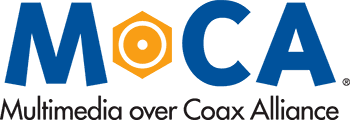Founded 2004 | ||
 | ||
Profiles | ||
The Multimedia over Coax Alliance (MoCA) is an international standards consortium publishing specifications for networking over coaxial cable.
Contents
- Geek beat archives cedia 2011 multimedia over coax alliance channel master internet to tv rev
- History
- Membership
- Technology
- MoCA 11
- MoCA 20
- MoCA 25
- Frequency band plan
- References
There are three versions of the specification currently available, MoCA 1.1, MoCA 2.0, and MoCA 2.5.
Geek beat archives cedia 2011 multimedia over coax alliance channel master internet to tv rev
History
MoCA was established in 2004.
MoCA 1.0 was approved in 2006, MoCA 1.1 in April 2010, MoCA 2.0 in June 2010, and MoCA 2.5 in April 2016.
Membership
The Alliance currently has 45 members including pay TV operators, OEMs, CE manufacturers and IC vendors.
MoCA’s board of directors consists of Arris, Broadcom, Comcast, Cox Communications, DirecTV, Echostar, Intel, MaxLinear and Verizon.
Technology
Within the scope of the Internet protocol suite, MoCA is a protocol that provides the link layer. In the 7-layer OSI model, it provides definitions within the data link layer (layer 2) and the physical layer (layer 1). DLNA approved of MoCA as a layer 2 protocol.
MoCA 1.1
MoCA 1.1 provides 175 Mbit/s net throughputs (275 Mbit/s PHY rate) and operates in the 500 to 1500 MHz frequency range.
MoCA 2.0
MoCA 2.0 offers actual throughputs (MAC rate) up to 1 Gbps. Operating frequency range is 500 to 1650 MHz. Packet error rate is 1 packet error in 100 million.
MoCA 2.0 also offers lower power modes of sleep and standby and is backward interoperable with MoCA 1.1.
MoCA 2.5
MoCA 2.5 (introduced April 13, 2016) offers actual data rates up to 2.5 Gbit/s, continues to be backward interoperable with MoCA 2.0 and MoCA 1.1, and adds MoCA protected setup (MPS), Management Proxy, Enhanced Privacy, Network wide Beacon Power, and Bridge detection.
MoCA Access is intended for multiple dwelling units (MDUs) such as hotels, resorts, hospitals, or educational facilities. It is based on the current MoCA 2.0 standard which is capable of 1 Gbps net throughputs, and MoCA 2.5 which is capable of 2.5 Gbps.
Frequency band plan
Notes:
